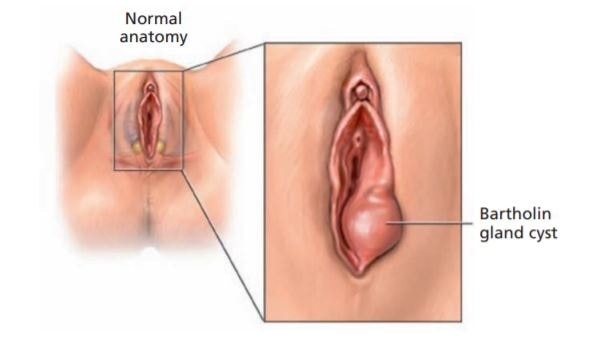Bartholin Cyst and Abscess
Bartholin glands are gland tissues located on the right and left of the vagina entrance, at 4 and 8 o’clock and opening to the vagina entrance with thin channels. Its main function is to provide slipperiness in the vagina entrance with the mucus-like fluid it secretes during sexuality.
The entrance of the Bartholin gland can be blocked for any reason. This cause is usually bacterial infections. Bacteria may be related to infection caused by protective vaginal flora bacteria in the vaginal flora, intestinal bacteria coming into vaginal entrance during toilet cleaning, or sexually transmitted diseases. In this case, the fluid secreted through the cloth will not flow out and will accumulate in the cloth. Swelling of the gland with a clean secretion is called Bartholin cyst. The cyst size is 1 cm. to orange size. At the entrance to the vagina, it can cause slight pain during daily life. As the cyst grows, the probability of pain increases. Discomfort, pressure or pain may be felt during sexual intercourse.
In Batholin abscess, the fluid inside the Bartholin cyst was infected and turned into an abscess focus. Bartholin abscesses are usually larger than cysts. It can cause severe pain in the form of throbbing and sometimes difficult to walk. He may watch hot. Redness and edema appear on the surface of the abscess.
Clinical examination is sufficient and typical for diagnosis. There is no need for any examination. Sexual intercourse is not necessary for the Bartholin gland, especially the infection, to clog and form a cyst or abscess. It can also be encountered in virgin women.
In order to avoid Bartholine cysts or abscesses, hygienic rules should be followed carefully. Using a condom during sexual intercourse will reduce the risk of infection.

Treatment of Bartholin cysts and abscesses
Bartholin cysts can be followed without treatment if they are small and the patient has no complaints. If the patient has complaints such as pressure, pain, and sexual disturbance, treatment is applied. Abseler will necessitate treatment.
In treatment, local anesthesia is applied to the side of Bartholin cyst or abscess at the vagina entrance towards the vagina entrance. Sedation anesthesia can be applied with the preference of the patient and evaluation of the current situation. An opening of 0.5-1 cm is created on the surface of the cyst or abscess tissue and the contents are completely emptied. It should be ensured that the infected material is completely emptied, especially if there is an abscess. At this moment, the patient will already feel a marked comfort. The surgical possibilities that can then be selected are:
* The opening can be expanded to some extent and left alone. If the diagnosis is abscess, antibiotics are definitely given. Hygienic rules and dressing applications are explained. The time determined by the physician, sexual intercourse, sea and pool are prohibited. There is no harm in standing bath. However, the mouth that is left on its own will tend to close again especially in case of abscess and the risk of recurrence of abscess or cyst will be high.
** After the contents of the cyst or abscess are emptied, approximately four stitches are placed so that the capsule of the Bartholin gland is mouth-swept. This process is called marsupialization. It can be applied with local anesthesia, but general anesthesia is a method that will increase the level of comfort. If it is an abscess, it is useful to use antibiotics. If it is a cyst, antibiotics are not required. However, the physician preference is the priority here. Again, hygienic rules should be observed and dressings should be applied, sexuality, sea and pool should be avoided. The physician will decide this period. There is no harm in standing bath.
*** As the third method, I will talk about the word catheter application that I prefer the most. After a 0.5 cm incision is made on the Bartholin cyst or abscess surface and the cyst contents are drained thoroughly, the word catheter reminiscent of a miniature urinary catheter is placed in the bartholin gland and its balloon is inflated for 4-5 cc. The remaining part of the word catheter is placed in the vagina and held there for 4-6 weeks. During this period in which the catheter remains, the diaper will form a new mouth (fistula). After 4-6 weeks, the fluid in the catheter is drained and the catheter is easily and easily removed. Local anesthesia is completely sufficient for this procedure and general anesthesia can be applied only in special cases if the patient wants it. Sea, pool and togetherness are prohibited during this time. During the menstrual bleeding, it is not possible to apply tampons with the word catheter. If applied for abscesses, antibiotics can be used. There is no harm in standing shower.
**** If the Batholin cyst or abscess recurs continuously despite surgical treatments, or if there are very rare cancer suspicions, the Bartholin gland can be removed. In this case, some physicians place silver nitrate inside the 1 cm incision implanted on the gland and the gland capsule is automatically disposed within a few days. Some physicians prefer to completely remove the Bartholin gland surgically. In cases where the Bartholin gland is completely removed with silver nitrate or surgery, the lubricant (lubricant) gels that can be used during sexual intercourse may be offered to the patient since the gland can no longer produce gland secretion.






 Turkish
Turkish Deutsch
Deutsch Bu İçeriği Beğendim
Bu İçeriği Beğendim